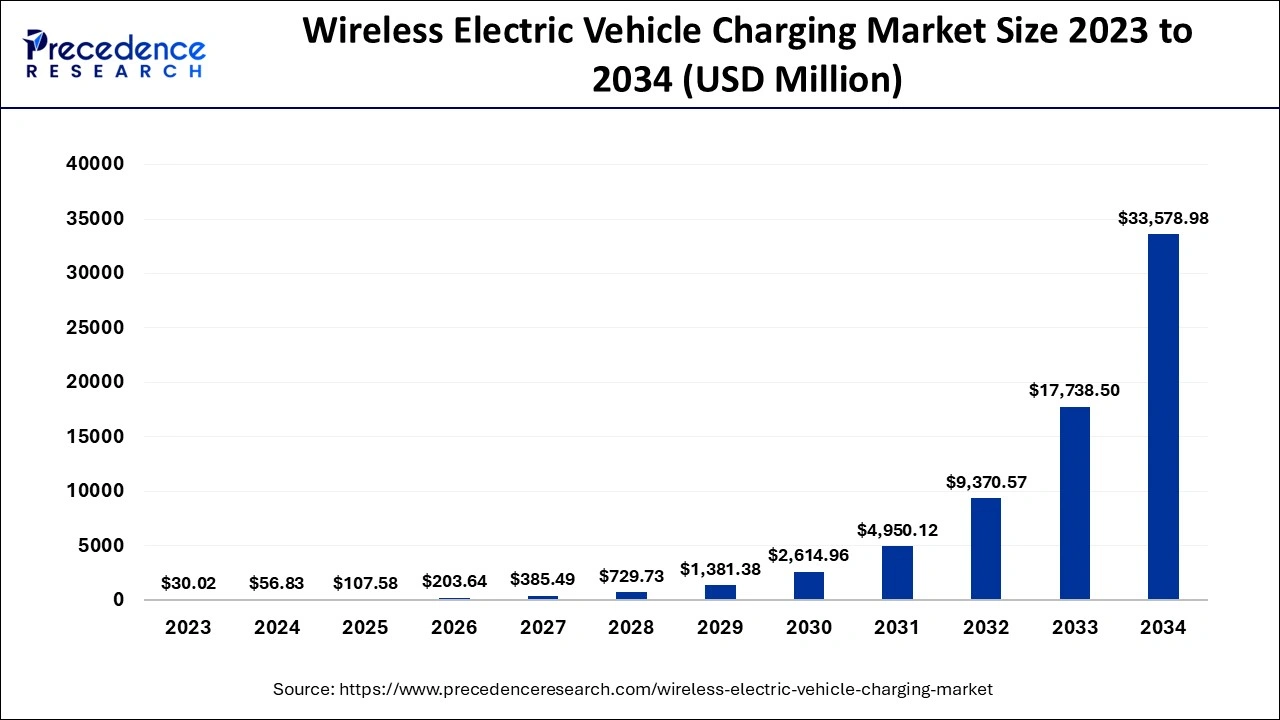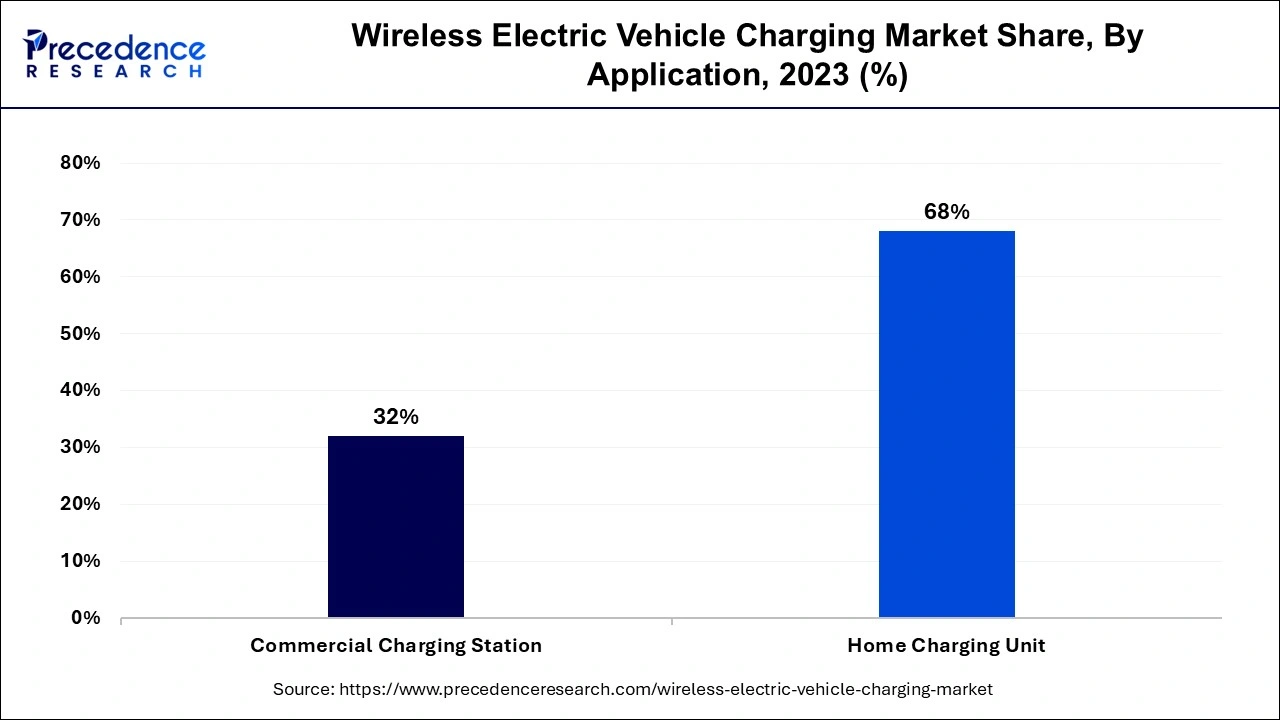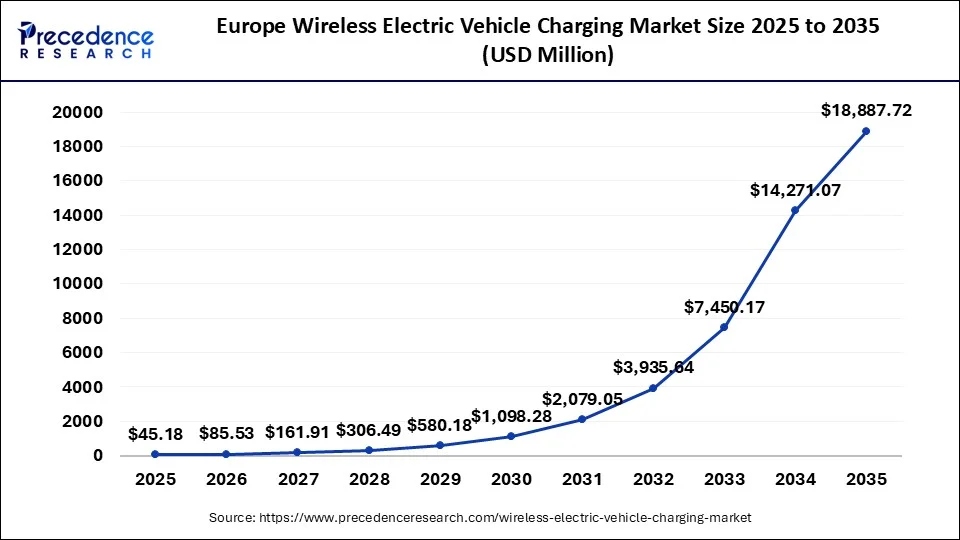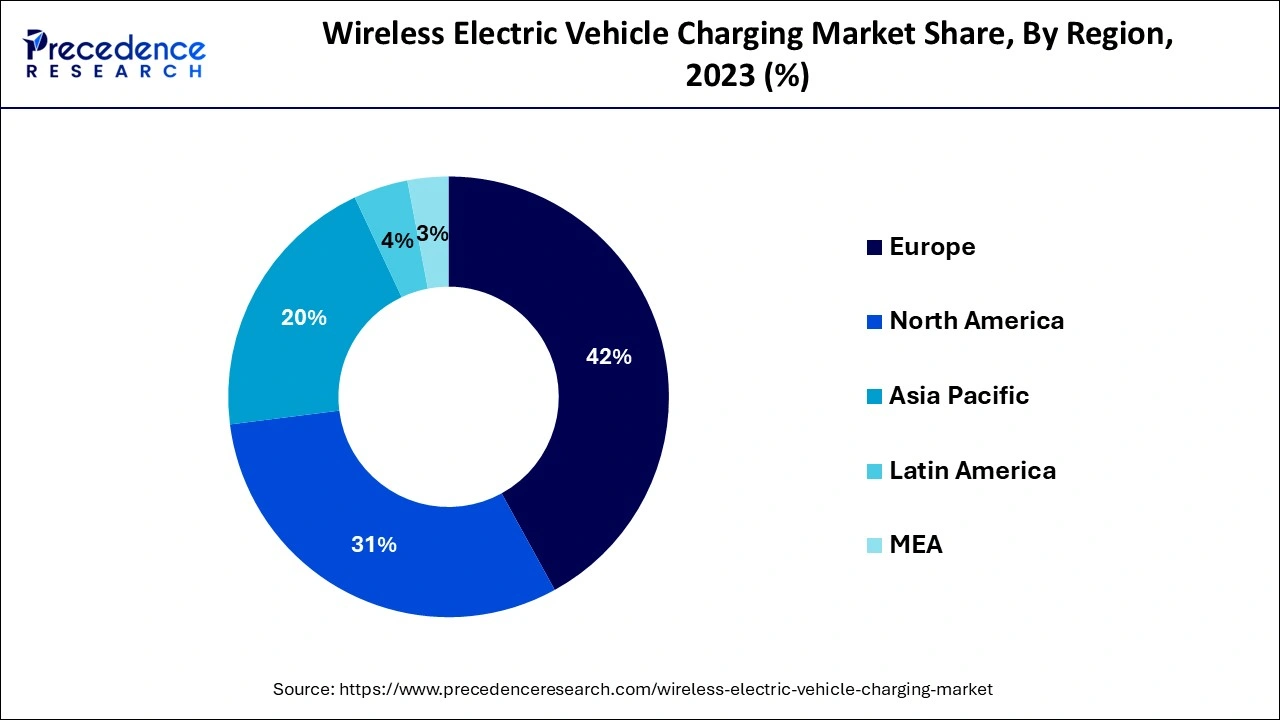What is Wireless Electric Vehicle Charging Market Size?
The global wireless electric vehicle charging market size is calculated at USD 107.58 million in 2025 and is predicted to increase from USD 203.64 million in 2026 to approximately USD 44,437.76 million by 2035, expanding at a CAGR of 82.64% from 2026 to 2035.

Market Highlights
- By application, the home charging unit segment accounted for 68% of revenue share in 2025.
- The commercial charging station segment hit a revenue share of around 32% in 2025.
- By distribution channel, the aftermarket segment accounted revenue share of around 61% in 2025.
- By charging method, the inductive power transfer segment hit 39% revenue share in 2025.
- By propulsion type, BEV segment accounted for 42% of revenue share in 2025.
- By installation, the commercial segment hit a revenue share of 82% in 2025.
- Europe region held the highest revenue share of over 42% in 2025.
Market Overview
Wireless electric vehicle charging involves charging of the vehicle without any cable and transmission of the energy is done through electromagnetic induction transmission of electrical energy to the vehicles. The vehicle to be parked and placing of the vehicles near the charging stations or the inductive pad and transferring of the electric power and second induction coil is placed in the vehicles which receives the power. It is the safe method of technology for transferring of the electric power, reliable and convenient. By eliminating the usage of cables and connectors and increasing the efficiency of the vehicles and cost effective and most reliable convenient method has increased the market trend. Impact of the covid-19 on the wireless electric vehicle charging has declined the market growth due to rules and regulations imposed by the government and shutdown of the nation with the ceased transportation which hampered the supply of goods from one end to another. Moreover, spread of corona virus affected the automotive market and the electric vehicles due to underdeveloped infrastructures has challenged the market to grow.
Wireless Electric Vehicle Charging Market Growth Factors
- Increasing number of populations with increased demands of the consumers increased market rate high during the forecast period.
- Increased development and rapid acceptance of the newly developed technologies across the world have increased the market to larger extent.
- Advanced developed technologies and new innovative features in the electric vehicle with rising demands of the market with developed infrastructures of charging stations have increased the market to a larger extent.
Moreover, wireless charging electric vehicle is about transmission of the energy without wire or cable magnetic induction is used for transmitting energy which is efficient, convenient, reliable, cost effective. Increased adaption of the wireless charging electric vehicles with benefits of emission free society with, higher efficiency, low maintenance, increased rates of the fuels and oils, developing infrastructure and increased research and development by the automotive industry have boost the market for increased revenue share of wireless charging electric vehicle market.
Support from the government with increased investing funds for developing more wireless charging electric vehicles and developing infrastructure of charging stations. The key market players involved in introducing, developing, manufacturing and producing with developed technologies have helped to boost the wireless electric vehicle charging market.
The pandemic effect on the wireless charging vehicle on the market led to low down the height of the market share due to less demands and manufacturing of the new integrated systems in the wireless charging vehicle technology increased investment from the market players with increased innovations hampered the manufacturing of the vehicles. Later with improved pandemic condition in the market led to higher demands from the consumers for the electric vehicle wireless charging with benefits such as low emission of the carbon dioxide gas with increased rates of the fuel overall regions have gained the consumers attention towards the wireless charging of the vehicle.
What are the Major Trends in the Market?
- Growth of Dynamic Wireless Charging Systems: There is increasing development of systems that allow EVs to charge while in motion, reducing the need for long stationary charging stops and enhancing convenience for longer journeys.
- Focus on Standardization and Interoperability: Industry efforts are accelerating to establish common standards and ensure wireless charging systems are compatible across different EV models and infrastructure, which helps drive adoption and reduce costs.
- Integration with Smart and Urban Infrastructure: Wireless charging is being embedded into smart city planning and roadways, enabling charging in urban environments, fleet depots, and public spaces to support a cable‑free, seamless charging experience.
- Rising Investment and Public‑Private Support: Governments and private players are increasing investments, pilot projects, and incentives to expand wireless charging infrastructure, particularly in commercial, municipal, and transit applications.
Market Outlook
- Industry Growth Overview: The wireless electric vehicle charging market is set for strong growth from 2025 to 2034. This expansion is driven by the increasing global adoption of EVs and the rising consumer demand for convenient, hands-free charging solutions that eliminate physical cables. The rapid expansion of charging infrastructure also drives the growth of the market.
- Major Trends: A major trend is the development of dynamic wireless charging, allowing vehicles to charge while driving over roads with inductive coils installed beneath the surface. Another crucial trend is the finalization and adoption of global standards, such as SAE J2954, which ensures interoperability among different EV models and charging pads.
- Global Expansion:The market is expanding worldwide, driven by the global push for zero-emission mobility and significant government support. Emerging regions offer substantial opportunities due to increasing investments in local EV production and infrastructure development, particularly across the Asia-Pacific and Europe.
- Major Investors:Large automotive and technology corporations, including WiTricity Corporation, Siemens AG, and Continental AG, are major investors. Investment is also being driven by significant public funding and R&D initiatives from government agencies.
- Startup Ecosystem: A vibrant startup ecosystem is emerging, focusing on niche innovations in dynamic charging, AI-enabled control software, and fleet integration. Startups like ElectReon are developing in-motion charging roads, while InductEV is integrating wireless charging into commercial vehicle fleets to reduce downtime.
Market Scope
| Report Coverage | Details |
| Market Size in 2025 | USD 107.58 Million |
| Market Size in 2026 | USD 203.64 Million |
| Market Size by 2035 | USD 44,437.76Million |
| Growth Rate from 2026 to 2035 | CAGR of 82.64% |
| Base Year | 2025 |
| Forecast Period | 2026 to 2035 |
| Dominating Region | Europe |
| Segments Covered | Power Supply, Vehicle, Application, Components, Charging Type, Distribution Channel, Propulsion Type, Charging System and region |
| Regions Covered | North America, Europe, Asia-Pacific, Latin America, and Middle East & Africa |
Market Dynamics
Drivers
Increasing number of populations with increasing number of demands from the market with improved developed technology have rise the market high. Rapid acceptance of the developed innovative technologies with increased benefits from the wireless electric vehicle charging such as ease of use, zero emission of carbon dioxide and increased global environment, higher efficiency, low maintenance and no wires and cables involved for charging decreased shock effects. The battery of the vehicle is charged through transmission of power from one magnetic coil to another coil. In wireless charging of electric vehicle size of the battery is smaller and light in weight as that of used in convenient vehicles. These two are major reasons for reducing the cost of the electric vehicles.
Faster charging of the wireless charging electric vehicle, they can charge the car wherever they have parked the vehicle. Increased awareness among the people with rising demands have extended the market to grow at a larger extent. Market players are major role players in new innovations across the regions and continuous research and development have contributed to increase the wireless electric vehicle charging with high demands and acceptance from the market.
Challenges
- Increased costing of the wireless electric vehicle - Increased advanced developments with improved technologies and features in wireless charging electric vehicle may led to increased costing of the wireless charging electric vehicles. This developed system is initially new developed features in introducing phase therefore the rates are high which may challenge the wireless electric vehicle charging market.
- Infrastructures of charging stations - Less developed infrastructures of charging stations have challenged the market to grow at a definite height. Need to develop more stations of wireless electric vehicle charging which will boost the market of wireless electric vehicle charging market.
- Upgrade of the wireless electric vehicle charging - Due to developed features with new technologies developed may led to update of the wireless electric vehicle charging with updated technologies which is not a simple task as it looks includes more complexations with rising cost.
- Low efficiency - Increased growth of wireless EV charging in the industry. Consumption of power is about 8-12% more in wireless electric vehicle charging and transfer of electric power through magnetic induction limited to a certain distance. Considering efficacy and safety issues may hamper the market to grow.
Opportunities
- Government Support - Increased support from the governments from various regions for developing and producing wireless EV charging vehicle with developing infrastructures of charging stations with increased demands from the consumers and market with improved benefits such as ease of use, low maintenance, high efficiency, reduced costing, smaller battery size, light weight of the battery, zero emission of the carbon dioxide, reduced storage of the wires or cables and no shocks have helped to boost the wireless EV charging market to a larger extent.
- The Key Market Players - The key market players involved in introducing newly developed technologies and features and increased investment from the automotive industry to manufacture and produce wireless EV charging with increased demands have expanded the market to grow high during the forecast period.
- Developing Nations - Increasing developments and more research and technology in the automotive industry with no emissions and decreased noise pollution with clean air no air contaminants have helped to the environment to be clean and green with nonharmful effects on the environment.
Segment Insights
Power Supply Insights
Segmentation of wireless electric vehicle charging based on the power supply it is divided in to 3 - <11 KW, 11 - 50 KW, >50 KW. The power supply of 3 -11 KW is the fastest expanding in electric supply of power it is used in small batteries and medium size batteries. It is the widest growing segment in household charging and at working place.
Propulsion Insights
Segmentation of wireless electric vehicle charging based on the basis of propulsion it involves BEV and PHEV. BEV is the highest growing sector to increase the market to a greater extent during the forecast period. In BEVs wireless charging is increased than in PHEVs. Source of energy and electric power is battery. BEV segment to enhance the market more than PHEV during the forecast period.
Vehicle Insights
Segmentation of wireless electric vehicle charging based on the basis of vehicle includes such as commercial vehicles and passenger cars. Passenger car to hold the highest position in the increased market revenue share an commercial vehicles to increase the market during the forecast period.
Segmentation of wireless electric vehicle charging includes various segments involves based on distribution channel includes aftermarket, OE market. Based on component includes base charging pad, power control unit, vehicle charging pad. Based on charging type such as Dynamic wireless charging system, stationary wireless charging system. Based on charging system includes magnetic power transfer, capacitive power transfer, inductive power transfer.
Application Insights
Segmentation of wireless electric vehicle charging based on the basis of application involves such as home charging unit and commercial charging station. Commercial charging station cover the rate at a CAGR of 45% with increased developments and technologies with developed infrastructures in various places with increased demand.

Home charging station involves medium and smaller size batteries with light weight with higher CAGR with enhanced utilization and increased market during the forecast period.
Regional Insights
Europe Wireless Electric Vehicle Charging Market Size and Growth 2026 to 2035
The Europe wireless electric vehicle charging market size is evaluated at USD 45.18 million in 2025 and is predicted to be worth around USD 18,887.72 million by 2035, rising at a CAGR of 82.86% from 2026 to 2035.

What Makes Europe the Dominant Region in the Wireless Electric Vehicle Charging Market?
Europe dominated the market by capturing the largest share in 2024. The European market is characterized by stringent emissions regulations and robust government incentives for electric mobility. The market is primarily driven by extensive R&D in the automotive and power electronics sectors, alongside pilot projects that integrate wireless electric vehicle infrastructure into smart city initiatives. The region places a strong emphasis on standardized interoperability and high-efficiency systems, particularly for seamless integration with commercial fleets and public transport systems to meet strict quality and safety standards.
Segmentation of wireless electric vehicle charging based on the basis of geography Asia Pacific region to be highest region to contribute to enhance the increased market revenue share with increasing demands from the market and consumers due to developed technologies. Other regions contributing for the increasing the market growth such as North America, Europe, Latin America, Middle East and Africa are also in process to increase the market to grow to a larger extent.

Germany Wireless Electric Vehicle Charging Market Trends
Germany is a major contributor to the market, driven by its world-renowned engineering expertise and a strong focus on advanced manufacturing and automotive innovation. The country serves as a hub for R&D in inductive power transfer systems, particularly for static charging solutions in parking garages and commercial settings. The market is heavily influenced by the presence of global automotive leaders and a commitment to integrating wireless electric vehicles into production lines.
What Potentiates the Growth of the Market in North America?
The wireless electric vehicle charging market in North America is driven by increasing electric vehicle (EV) adoption, government incentives, and robust research and development efforts. The region is focusing on deploying efficient and convenient charging solutions for both stationary and dynamic applications, supported by collaborations between automakers and technology providers.
U.S. Wireless Electric Vehicle Charging Market Trends
The U.S. remains the main growth driver within North America's market, fueled by ambitious federal targets and substantial investments. Key trends include the early adoption of wireless electric vehicles by commercial fleets, integration into smart city infrastructure, and the development of innovative technologies by domestic companies. The focus is on convenient park-and-charge solutions to encourage consumer adoption of EVs.
How is Latin America Emerging in the Wireless Electric Vehicle Charging Market?
Latin America plays a major role in the global wireless electric vehicle charging market. The market in the region is fueled by increasing urbanization, rising investments in sustainable transportation infrastructure, and the expansion of electric bus fleets in major cities such as Santiago and S�o Paulo. The region is focused on developing robust public charging networks to meet the increasing demand. The market is also driven by collaborations between local governments and international technology providers, with early adoption expected in private, residential, and commercial parking areas.
Brazil Wireless Electric Vehicle Charging Market Trends
Brazil is leading the market in Latin America, driven by significant investments in renewable energy and the need to upgrade data and power infrastructure. The increasing demand for fast charging in major urban centers is accelerating the adoption of innovative solutions. Additionally, a growing focus on smart cities and the use of wireless electric vehicles in public transportation and logistics is stimulating market growth.
What Opportunities Exist in the Middle East & Africa?
The Middle East & Africa (MEA) offers significant opportunities in the wireless electric vehicle charging market, driven by ambitious government visions for sustainable energy, extensive smart city development, and strong economic diversification initiatives away from fossil fuels. There is a significant demand for premium, aesthetically pleasing, and robust charging systems that blend seamlessly into urban landscapes and luxury residences. Investments in advanced infrastructure and a growing demand for modern transportation and logistics solutions.
UAE Wireless Electric Vehicle Charging Market Trends
The UAE plays a significant role in the wireless electric vehicle charging market because of its ambitious technological goals and smart city programs. The country is making major investments in advanced transportation solutions, including autonomous and electric vehicles that can utilize seamless, in-ground charging. There is also a high demand for premium wireless charging applications in luxury properties and public parking areas, driving the growth of these technologies.
What Factors Drive the Growth of the Wireless Electric Vehicle Charging Market in Asia Pacific?
The growth of the market in Asia Pacific is driven by surging electric vehicle adoption across the region, supported by aggressive government policies, subsidies, and infrastructure targets in countries like China, Japan, and South Korea. Technological advances in wireless charging, particularly higher power, improved efficiency, and integration with smart-grid/smart-city systems, are boosting consumer and fleet operator confidence in the technology. Furthermore, rapid urbanization and limited parking space in dense cities increase the appeal of cable-free, efficient charging solutions.
Value Chain Analysis
- Research & Development (R&D)
Focuses on innovating core wireless power transfer (WPT) technologies and developing global standards like SAE J2954.
Key Players: WiTricity Corporation, Qualcomm Technologies, ElectReon Wireless Ltd., and HEVO Inc. - Component Manufacturing and Production
Involves designing and mass-producing hardware such as charging pads, vehicle receiver pads, power control units, and communication modules.
Key Players: Toshiba Corporation, Continental AG, Robert Bosch GmbH, and ZTE Corporation. - System Integration and Automotive OEM Partnerships
Integrates the technology into new vehicles and develops aftermarket solutions through partnerships between tech providers and automakers.
Key Players: BMW, Nissan, Hyundai, Volvo, Stellantis, Continental AG, and Robert Bosch GmbH. - Infrastructure Deployment and Installation
Physically installed charging pads in various locations, including homes, commercial lots, public stations, and electrified roadways for dynamic charging.
Key Players: ChargePoint, EVgo, and ElectReon. - Software & Network Services
Develops the digital infrastructure for authentication/payment, and systems for smart charging and V2G applications.
Key Players: Evy Energy and TeslaVolts. - Operation, Maintenance & Customer Support
Ensures network reliability, performs remote monitoring, and provides maintenance and customer support services.
Key Players: WAVE Charging and Chargewerx Wireless.
Wireless Electric Vehicle Charging Market Companies
- Toyota Motor Corporation: Toyota is partnering with technology developers to co-develop and evaluate advanced wireless EV charging systems, including aftermarket kits and integration into future electric vehicles.
- Toshiba Corporation: Toshiba has developed wireless power transmission technology for electric vehicles capable of delivering substantial charging power via contactless pads, enhancing convenience and safety.
- TGOOD Global Ltd: TGOOD Global is building and operating EV charging infrastructure and networks that include support for advanced wireless and next-generation charging solutions.
- Momentum Dynamics Corporation: Momentum Dynamics specializes in high-power wireless charging systems for electric vehicles, focusing on automated inductive charging platforms suitable for buses, commercial fleets, and opportunity charging without cables.
- Tesla: Tesla's wireless EV charging efforts have been explored internally, but recent reports indicate the company has paused or discontinued formal development of inductive wireless charging technology for its production EVs.
Other Major Key Players
- Robert Bosch GmbH
- Coninental AG
- ZTE Corporation
- HELLA GmbH & Co. KGaA
- WiTricity Corporation
- Qualcomm Technologies
- Powermat Technologies
- Renesas electronics
- Nidec mobility corporation
- Evatran group
Recent Developments
- In September 2025, Porsche introduced an 11 kW wireless charging system for electric vehicles, becoming the first automaker to bring a user-friendly one-box solution, requiring only a floor-mounted plate without a wallbox or control unit, to market.
(Source:newsroom.porsche.com)
In May 2025, C-DAC (T) and Visvesvaraya National Institute of Technology (VNIT) Nagpur jointly developed an EV wireless charger. The Charger is capable of charging the battery to 90% in just three hours.
(Source:energetica-india.net) - In the year 2021 May, HEVO developed ground-based pad and started manufacturing and production in Flex contract manufacturing facility in Austin, Texas. Which is estimated to give 200 units order received in the first quarter of 2021.
- In the year 2021 December, Toyota Motor Corporation working on developing the new technology such as wireless electric power transfer system that charge the vehicle even while driving the vehicle. In this system it involves systems integrated in roads on highways to charge, or city intersections.
- In the year 2021 October, WiTricity introduced new patented technology wireless charging for BEVs in South Korea. Hyundai Genesis will use wireless charging technology which is the first electric battery vehicle launched in the year 2018. By the year 2022, the genesis GV60 will be available in South Korea.
Segments Covered in the Report
By Power Supply
- 3 - < 11 KW
- 11 - 50 KW
- >50 KW
By Vehicle
- Commercial Vehicles
- Passenger Cars
By Application
- Commercial Charging Station
- Home Charging Unit
By Components
- Base charging pad
- Power control unit
- Vehicle charging pad
By Charging Type
- Dynamic wireless charging system
- Stationary wireless charging system
By Distribution Channel
- Aftermarket
- OE Market
By Propulsion Type
- BEV
- PHEV
- CEV
By Charging System
- Inductive Power Transfer
- Capacitive Power Transfer
- Magnetic Power Transfer
By Region
- North America
- Europe
- Asia-Pacific
- Latin America
- Middle East & Africa (MEA)
For inquiries regarding discounts, bulk purchases, or customization requests, please contact us at sales@precedenceresearch.com
Frequently Asked Questions
Ask For Sample
No cookie-cutter, only authentic analysis – take the 1st step to become a Precedence Research client




 sales@precedenceresearch.com
sales@precedenceresearch.com
 +1 804-441-9344
+1 804-441-9344